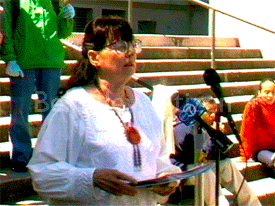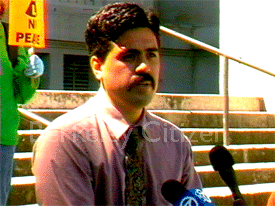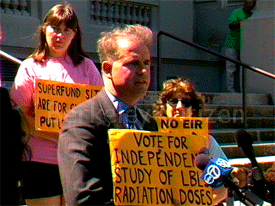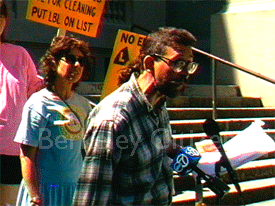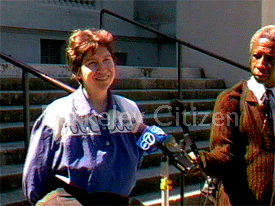
Berkeley Community Says No to
DOE Lab's Radioactive Releases
Berkeley Says No to DOE Lab's Radioactive Releases Berkeley's community says no to the Lawrence Berkeley National Lab airborne Tritium Releases. Berkeley community members of the Lawrence Berkeley National Laboratory/DOE "Tritium Issues Work Group" made an official withdrawal from all participation after many months of meetings. Press conference includes speakers Carlos Plazola, aide to Congresswoman Barbara Lee, Berkeley City Councilmembers Dona Spring & Kriss Worthington and Berkeley community members Gene Bernardi, Pamela Sihvola, John Selawsky, L A Wood, Protap Chatterje, and Carolyn Erbele Produced by Berkeley Citizen
|
||||||||||||
|
City Pulls Out of Tritium Talks
Marc Albert, Berkeley Voice, April 29, 1999
Negotiations over radioactive testing at Lawrence Berkeley National Laboratory broke down last Thursday, as city commissioners and watchdogs resigned from talks and accused the lab of stonewalling.Talks between community members, lab officials, and state and federal regulators have continued for two years in the form of the Tritium Issues Work Group at the request of the Berkeley City Council. The group was charged with finding out what health risks, if any, exist due to the lab's production of tritium, a radioactive isotope of hydrogen used to trace other medicines in common medical treatments.
The lab and federal Environmental Protection Agency officials insist the lab's work presents no danger.
"There's no immediate health hazard. It's well below regulatory limits within the Clean Air Act," said Mike Bandrowski chief of radiation protection at the EPA's San Francisco office.
But critics contend the lab is deliberately holding back information.
"This is a public health issue for the citizens of Berkeley and Oakland, and they have every right for a full accounting of the lab's activities. The lab hasn't recognized that the community has that right," said Community Environmental Advisory Board Chair John Selawsky.
Selawsky met with Mayor Shirley Dean and lab director Charles Shank Tuesday, but Selawsky said any details worked out to resume negotiations would have to be approved by his committee.
"What it boils down to is that CEAC and lab critics want the Institute for Energy and Environmental Research to review sampling and data and determine what needs to be done. The lab also has to make more information available," Selawsky said.
EPA and lab officials contend that they are close to presenting an independent sampling plan. Brandroski called the data requested "irrelevant." But critics from the Committee to Minimize Toxic Waste said the lab is stonewalling their Freedom of Information Act request by charging $47,000 for the photocopies.
Dissidents were buoyed at Thursday's press conference by appearances by Councilwoman Dona Spring, Councilman Kriss Worthington, and a representative of Congresswoman Barbara Lee.
"For various reasons, including lack of cooperation between members of the group," read Lee's statement, "and the inability to push the few decisions made through to implementation, the Tritium Issues Work Group has been almost completely ineffective in reaching the desired goal of understanding the extent of contamination at the Lawrence Berkeley National Lab caused by the National Tritium Labeling Facility."
The lab and regulatory officials said they would wait for direction from the Berkeley City Council on whether and how to proceed.
"It's unfortunate that some members of the community have pu1led out," said lab spokesperson Terry Powell, "but we are committed to continuing with other community members and regulators and we remain committed to independent sampling."
In the press conference, critics said the lab's promise of $100,000 in funding for independent sampling was a "public relations ploy." The CMTW maintains that LBNL was never serious about turning over funding to the TIWG.
Lab officials and critics have been at loggerheads over hiring IEER to do the sampling. The CEAC members say IEER is a respected scientific firm employed by the government to review practices at Los Alamos National Laboratory.
IN BRIEF: Tritium Press Conference Rebroadcast
The Earth Day '99 press conference denouncing the use of tritium at the Lawrence Berkeley National Laboratory will be broadcast on Berkeley Public Access, B-TV Channel 25 today at 5:30 p.m.; Friday, April 30 [1999] at 6 p.m. and Saturday, May 1 at 6:30 p.m.
Speakers include Carlos Plazola, aide to congresswoman Barbara Lee; City Council members Kriss Worthington and Dona Spring; and Gene Bernardi, Pamela Sihvola and L A Wood of the Committee to Minimize Toxic Waste
Plan Outlines Closure of Tritium Facility
John Geluardi, Berkeley Daily Planet, January 5, 2002Dismantling the Tritium Labeling Facility will take about one year and cost more than $1 million, Lawrence Berkeley National Laboratory officials told a citizens group Thursday.
LBNL Radiological Control Manager Gary Zeman presented the three-phase work plan to the Community Environmental Advisory Commission for dismantling the controversial laboratory in Building 75. There the radioactive isotope, tritium, had been attached to medical research compounds for 19 years.
The lab announced the closure of the facility in September, shortly after the National Institutes of Health withdrew funding for the tritium lab.
"I have two goals, the safe and orderly closure of the facility and to return the facility to reuse for other activities," said Zeman, who will manage the closure project team.
Zeman said during the first part of the closure -- already underway -- radioactive materials and hazardous chemicals will be removed. Equipment and apparatus used in tritium-related projects will be dismantled during the second phase, and decontamination of the facility will take place during the third phase, rendering it safe for other uses.
According to the work plan, the facility "may have extensive tritium contamination on laboratory facilities and equipment such as hoods, lab benches, floors, walls and sinks."
It adds: "Those items that cannot be decontaminated to acceptable levels will have to be removed and disposed as low level radioactive waste before the spaces can be returned to use."
Commissioner L A Wood asked the CEAC to send a recommendation to the City Council asking it formally to request LBNL not to use the facility for any research that involves radioactive materials. The recommendation failed by a 4-3-1 vote with commissioner Elmer Grossman, Dan Luten and Sarah MacKusick voting in opposition. Commissioner Robert Clear abstained.
MacKusick said she voted against the recommendation because it was like "tilting at wind mills."
"If this recommendation is just going to be a symbolic gesture that will have no affect on the lab's decision, then I prefer not to do that," she said.
Prior to the vote, Wood said he was skeptical of the lab's sincerity.
"I am extremely disappointed in the work plan," Wood said. "I don't see how the lab can begin to close down the facility while it is conducting a treatability study that will require (the use of ) the facility's equipment."
Wood was referring to the treatability study, recently re-approved by the state Department of Toxic Substances Control, that will dispose of five liters of mixed waste that contain tritium and other hazardous waste by a experimental process known as catalytic chemical oxidation.
Community members have expressed concern about the study because the process was being used in July 1998 when 35 to 50 curries of tritium was accidentally released into the atmosphere. Normally the lab released between 50 to 100 curries during the course of a year. The state Department of Toxic Substances Control deemed the release below state and federal standards, although the agency halted the experimental process after the state's investigation in 2000.
Zeman said the equipment required to conduct the study safely, including an exhaust ventilation and radiological monitoring equipment, will not be dismantled until the study is complete in the next few months.
Former CEAC Chair John Selawsky asked Zeman for a more detailed schedule.
"I have a sense that the lab is being sincere about their intention to dismantle the facility," he said. "But I'm not entirely convinced, after all we were told the facility was closing in December and now we find out they just received approval to conduct an experimental treatability study."
Zeman said it would be difficult to provide a detailed schedule because lab materials are still being inventoried and the extent of the contaminated lab equipment has not yet been determined.
But he said the removal of the remaining 12,000 curies of tritium stock has already begun; it was shipped to Lawrence Livermore National Laboratory on Dec. 20.
According to a tentative schedule, the first phase will be completed by spring. The second phase, which has also begun, will be completed this summer.
"The scope and content of the Phase 3 activities will be planned by summer 2002 and a budget for this work will prepared and submitted to the Department of Energy," the work plan reads. "Work activities associated with Phase 3 will begin following budget approval."
Community Claims Victory in Tritium Facility Closure
John Geluardi, Berkeley Daily Planet, September 15, 2001Causing a citywide sigh of relief, Lawrence Berkeley National Laboratory officials announced Friday that the lab's radioactive tritium facility has lost funding and will close by early December.
According to a joint press release from LBNL and the National Institute of Health, the NIH has withdrawn the facility's $1 million annual funding because of a shortage of physicists, too few tritium-related research projects and the NIH's intention to invest in other forms of cell-imaging techniques.
But severa1 city officials said the announced closure was the result of intense public pressure put on lab by the Committee to Minimize Toxic Waste, an organization spawned from a Berkeley neighborhood group.
LBNL spokesperson Ron Kolb said the facility will close in December after which a six-month dismantling of tritium labeling equipment, much of it radioactive, will begin.
"It will take another year after that to decontaminate the place before the building can be used again," Kolb said.
He added the facility's four employees have been given their severance notices and that the laboratory is trying to place them in other laboratory departments.
The National Tritium Labeling Facility, which is managed by LBNL, provides medical researchers with the radioactive isotope tritium. The lab attaches the tritium to pharmaceuticals and other medical compounds, in a process known as labeling, so they can be accurately traced as they course through the human body.
The facility, which opened in 1992, has been controversial since 1996 when a neighborhood group, the Committee to Minimize Toxic Waste began asking questions about how LBNL stores and disposes of tritium. The group was also concerned about the labeling process which requires the release of varying amounts of tritium through an emissions stack. The stack is located 500 feet from the Lawrence Hall of Science, which is visited by an average of 150,000 children each year.
Last year the City Council commissioned a study of the tritium facility by the Institute for Energy and Environmental Research, in Heidelberg, Germany. The $33,000, 53-page report, evaluated the level of public exposure to tritium and assessed potential health risks. The final version of the report was released on Aug. 23.
Dr. Bernd Franke, who prepared the report, concluded that data, provided by the facility, showed tritium emissions were lower than the Environmental Protection Agency's recommended exposure levels. But Franke suggested the laboratory deploy more tritium air monitoring equipment around the facility.
Franke also challenged an LBNL report that claimed the labeling facility posed no, or very little, risk in the event of a fire, earthquake or other disaster.
The City Council unanimously approved a resolution calling for the closure of the tritium facility in 1996 and again in 1998.
"I'm really greatly relieved that we will have this potential danger closed down," said councilmember Polly Armstrong, who represents District 8 where the facility is located. "Nobody doubts the good work being done with tritium, but it doesn't belong in a dense urban area known for fires, earthquakes and landslides. It belongs in the desert where less damage is possible."
Mayor Shirley Dean also expressed relief, "I can't help but feel relieved by (the news)," she said, "I had been reassured by recent studies that the facility wasn't a huge threat, but the City Council took the stance that the facility should be closed."
Councilmembers Kriss Worthington and Dona Spring said the closure is a victory for the neighbors who were tireless in their efforts to close the facility.
"The Committee to Toxic Waste wrote countless letters, visited congresspeople, senators and lobbied and lobbied and lobbied," Spring said. "This is just a tremendous victory for the community."
CMTW member Gene Bernardi, who began challenging LBNL activities in 1992 over hazardous waste storage, said the news was stunning. "I'm incredulous, but delighted if it's true," she said. "I think they must have finally come to their senses."
Pam Sihvola said the committee has been working day and night to close the facility since 1996. Sihvola said she was very grateful to the City Council and all the other organizations that have lent their support.
"Victory, victory for the community," Sihvola said. "The message here is that great things can be accomplished when the community holds together."
Sihvola added that the dismantling process will be closely monitored by the CMTW.
Community Environmental Advisory Commissioner L A Wood, who has worked for the closure of the facility, said at first it was difficult just learning about the complexities of tritium and the procedures involved with the labeling process.
"In 1996 no one understood anything about tritium," Wood said. "But all the work over the years finally reached a critical mass and closed the facility."
Both Dean and Armstrong said the closure of the tritium facility will allow the good work the LBNL does to be put in the spotlight. Armstrong commended the lab's breast cancer research and its development of energy efficient technology.
"There are a lot of good people there who are doing a lot of good work," she said.
All Rights Reserved
